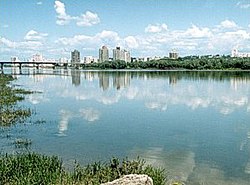Dneister
| Dniester | |
|
Rîbnița and the Dniester river
|
|
| Countries | Ukraine, Moldova |
|---|---|
| Cities | Tiraspol, Bender |
| Source | |
| - location | Ukrainian Carpathians |
| - elevation | 900 m (2,953 ft) |
| - coordinates | 49°12′44″N 22°55′40″E / 49.21222°N 22.92778°E |
| Mouth | Black Sea |
| - location | Odessa Oblast |
| - elevation | 0 m (0 ft) |
| - coordinates | 46°21′0″N 30°14′0″E / 46.35000°N 30.23333°ECoordinates: 46°21′0″N 30°14′0″E / 46.35000°N 30.23333°E |
| Length | 1,362 km (846 mi) |
| Basin | 68,627 km2 (26,497 sq mi) |
| Discharge | |
| - average | 310 m3/s (10,948 cu ft/s) |
|
Map of the Dniester basin
|
|
The Dniester River, or Dnister River (/ˈniːstər/ NEES-tər;Ukrainian: Дністе́р translit. Dnister, Romanian: Nistru, Polish: Dniestr, Russian: Днестр, Turkish: Turla) is a river in Eastern Europe. It runs first through Ukraine and then through Moldova (from which it separates the breakaway territory of Transnistria), finally discharging into the Black Sea on Ukrainian territory again.
The name Dniester derives from Sarmatian dānu nazdya "the close river." The Dnieper, also of Sarmatian origin, derives from the opposite meaning, "the river on the far side". Alternatively, according to V. Abaev Dniester would be a blend of Scythian dānu "river" and Thracian Ister, the previous name of the river, literally Dān-Ister (River Ister). The Ancient Greek name of Dniester, Tyras (Τύρας), is from Scythian tūra, meaning "rapid." The names of the Don and Danube are also from the same Proto Indo-European word *dānu - river.
...
Wikipedia


